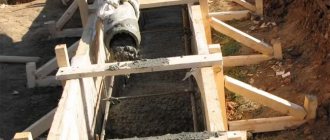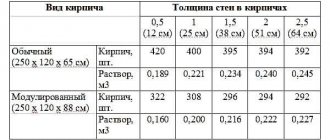During construction work, it is important to calculate in advance how much concrete will be needed, because both shortage and excess mean financial losses. If we know how many cubes in a concrete mixer are delivered in one trip, then we can accurately calculate the total amount of concrete received from the supplier. Let's consider different types of concrete mixers, features of the device and methods for determining the amount of cement mortar that is placed in them.
Concrete mixer for home Source mot16.ru
How do concrete mixers work?
These devices are designed to mix and deliver liquid solution to clients. They contain the following structural elements:
- A drum containing a liquid solution. The power of the concrete mixer depends on the size and type of container.
- The bed is the basis of the structure. All other nodes are located on it. The frame consists of pipes and profiles. Some brands of concrete mixers have a chassis for ease of use.
- Parts used to mix the solution. Blades or augers can be used for this purpose.
- The engine and transmission that rotate the mixer. It can be gasoline or electric.
- A control unit is used to turn on, turn off or change the rotation speed of the concrete mixer.
These nodes are present in all such devices.
Preparation of the solution Source www.rmnt.ru
Concrete pump, machine for pumping and delivering concrete to heights
A concrete pump is a special device for supplying mortar during the process of pouring buildings and structures, which is very often used on construction sites. In this way, it is possible to significantly improve the quality and productivity of concrete supply by automating part of the process.
Thanks to the concrete pump, the construction mixture is supplied to the pouring site quickly and accurately, the solution can be placed on time (before setting begins), significantly simplifying the processes of preparing, transporting and supplying the material to the construction site. The main advantage of a concrete pump is the ability to quickly remove and pump fresh mixture from a concrete mixer without labor and time.
In addition, the unit is used to supply concrete to a height, which is generally difficult to achieve with manual labor. There are a large number of concrete pumps on the market, which differ in type of installation, operating features, power and performance, and control. And before choosing a specific option, it is advisable to carefully study all the specifications.
Classification
Concrete mixers can have different designs. They are classified according to several criteria.
By mixing method
In gravity mixers, the internal screw is stationary, and the container with the solution rotates. Under the influence of gravity, the solution falls from the walls, gradually mixing. By changing the inclination of the tank, you can increase or decrease it, controlling the intensity of work.
These concrete mixers can use various mixing methods:
- Inside the drum there is a gear ring located around the entire circumference. A cast iron crown is considered less expensive, but it produces a lot of noise during operation. The plastic crown does not have this drawback. The most expensive option is to use one that is made of steel. In this case, the solution is not protected from the ingress of random debris.
- The gear method is considered the most reliable. Its repair is more complex compared to the coronal one.
Cast iron gear rim Source prom.st
The advantages of this kind of mixers are:
- Due to the fact that relatively little power is required for operation, energy consumption during operation is reduced.
- These models usually have wheels, which makes it easy to move the concrete mixer to the desired location.
However, this type of device has disadvantages:
- The tank needs to be cleaned and washed after each use, which is a labor-intensive procedure. If you do not do this, then gradually a thick layer of dried mortar will be deposited inside, which will complicate work in the future.
- Sometimes the solution splashes out while stirring.
- It is difficult to scoop out the prepared solution, so it is usually first poured from the reservoir into a special trough.
For operation, electric motors are used that require connection to a supply voltage of 380 volts. This is not convenient for all builders.
Preparing for unloading Source veralline.com
Forced action devices include a stationary reservoir and a rotating mixing part. Such devices are convenient in cases where a little water is needed or when using special additives.
Typically, such concrete mixers are large in size, and therefore they are not profitable to use where the volume of work is small.
Such devices are characterized by the following advantages:
- They provide high-quality mixing of the solution.
- Extraction of the prepared solution can be dosed.
In such devices, the following problem can sometimes occur. If the solution is not sufficiently cleaned, it may contain stones or other debris that can jam the rotating part, getting between it and the mixer body.
Forced action concrete mixer Source www.prostanki.com
By continuity of action
Some devices can mix continuously. This helps maintain the quality of the solution for as long as necessary, but requires a lot of energy.
There are concrete mixers that periodically turn off during operation. This reduces energy consumption. Typically, cyclic mixers are used in private construction. When thinking about how to choose a concrete mixer for your home, you need to consider devices of this type.
By type of energy used
A concrete mixer requires energy to perform mixing.
Mixer powered by an electric motor Source domostroi26.ru
It may have the following sources:
- In some cases, a manual drive is used. The work requires significant labor costs. However, such mixers have the advantage of high autonomy. The disadvantage is the small volume of the solution being processed.
- A hydraulic drive can be used. In order to ensure rotation, it is necessary to provide a high-pressure fluid supply. Additional equipment is required during operation. Such mixers are used in industrial settings.
- Some concrete mixers rotate using a pneumatic drive. Since this is ensured by the use of special devices, they are usually used for industrial construction sites.
- If a diesel or gasoline engine is used, this allows you to combine power and autonomy. However, during operation, such mixers make loud noise and produce exhaust fumes. The operation requires purchasing fuel on a large scale.
Powered by a diesel engine Source sc01.alicdn.com
- Electric motors are the most popular. They combine high power and relatively economical consumption of resources. They are used for mixers of various capacities: from 30 to thousands of liters.
Of all of these, electric motors have the most universal application. To know how to choose a concrete mixer, you need to determine which motor is more profitable to use.
See also: Catalog of companies that specialize in equipping foundations and installing stoves and fireplaces.
The influence of network voltage on equipment operation
When choosing equipment, you should also take into account the voltage in the network. If it is possible to connect to a three-phase network, this parameter can be ignored. If it is missing, purchasing or renting a unit with a voltage of 380 V will be a waste of money.
In any case, private construction work does not require the purchase of equipment operating from a three-phase network. It is only necessary on large construction projects.
Delivery
Concrete mixers are a convenient way to prepare cement mortar. For some chassis-mounted varieties, there is another application: with their help, industrial companies deliver the solution to customers, maintaining it in a liquid state. The width of the Kamaz concrete mixer allows you to deliver a significant amount of mortar in one trip.
Of course, you can make the solution yourself, but you need to spend some time on it and you cannot guarantee the high quality of the concrete obtained in this way.
Concrete is made this way without a concrete mixer Source yandex.net
It is convenient to use the services of specialized companies that will not only prepare the cement mixture of the required brand, but also deliver the liquid mixture, ready for use, directly to the construction site.
Receiving such services has its positive aspects:
- The supply of solution for preparing concrete occurs quickly and efficiently. This is beneficial both for the construction of private houses and for large construction projects.
- With the help of mixers, delivery can occur over long distances without loss of quality.
- When providing services, it is usually provided not only for the unloading of manufactured products, but also for the direct pouring of cement mortar.
This sales method allows the client to order exactly the volume of solution that he needs.
Mixer unloading time
How many cubes of concrete a mixer can hold can be found out by analyzing the time it takes to completely empty it. On average, 1 m3 of concrete is unloaded in 5 minutes. This means that unloading a 6 m3 drum will take 30 minutes. These are very approximate data, because... unloading time depends on parameters such as the density and hardness of the concrete mixture, as well as on specific conditions. For example, when installing ABS on a non-level surface, the unloading time will be increased. To correctly assess the capacity of the mixer based on unloading time, it is necessary that the ABS stands on a flat, hard surface with a slope of no more than 6%.
As a rule, concrete producers include in the delivery price the standard unloading time plus a reserve for various maneuvers, which ultimately amounts to 1 hour. During this time, a mixer with a volume of 6 cubic meters manages to unload.
When ordering concrete delivered by mixer, you must take into account the GOST 7473-94 standards for the maximum permissible duration of transportation of the mixture:
| Mixture grade according to workability | Type of road surface | Average transportation speed, km/h | Duration of transportation, min. | |
| concrete mixer truck | dump truck | |||
| Z2-Z1 P1 P2 P3-P5 | Rigid (asphalt cement, asphalt concrete, concrete) | 30 | 210 | 60 |
| 210 | 60 | |||
| 150 | 40 | |||
| 90 | 30 | |||
| Z2-Z1 P1 P2 P3-P5 | Soft (ground) | 15 | 60 | 40 |
| 45 | 30 | |||
| 30 | 20 | |||
| 20 | Not recommended | |||
| Note: when the temperature of the mixture or the environment changes, the maximum permissible duration of transportation is determined experimentally. | ||||
Selecting a concrete mixer
The following are some tips on how to choose a concrete mixer for your home and garden:
- It is necessary to determine what volume the drum should have: up to 100, 100-150, 150-300, more than 300 liters.
- The thickness of the drum walls matters. If the mixer is purchased for private construction, then 2 mm is sufficient for solid walls, and 4 mm for welded seams.
- When determining the required volume, you need to take into account. That optimal performance is achieved not when fully loaded, but when two-thirds full. In this case, the quality of the mixture will be higher.
- For private construction, it is preferable to purchase a device that uses a crown. It is advisable to buy those that use a part made of polymers.
- The device power of 700 W is most suitable for private low-rise construction.
Other nuances
Construction of a concrete mixer
The impressive weight of a stationary installation requires some effort to transport it. A small volume concrete mixer weighs much less than a larger unit. Therefore, in the absence of assistants, it is necessary to choose an installation on wheels.
Having figured out how much volume of a concrete mixer is required to perform certain jobs, you need to determine the optimal number of revolutions. This parameter affects the performance of the equipment.
In everyday life, concrete mixers are most often used, in which the number of revolutions does not exceed 28 per minute. Increasing the drum speed allows you to get a solution that will set much faster.
Video on the topic: Mixing the solution
Publications on the topic
Rating of Russian-made concrete mixers
The amount of cement in 1 cube of concrete is an indicator that determines the quality of the finished solution
Determining the proportions of concrete in buckets for a concrete mixer
Rating
If you plan to purchase a mixer for working at home, it makes sense to pay attention to the following rating of concrete mixers, which includes popular and high-quality models:
- RedVerg RD-CM 63
It has a drum volume of 63 liters. It is suitable for building a summer house. This concrete mixer can be purchased at an affordable price. She has a high-quality polymer crown. Disadvantages are loud noise,
- Concrete mixer Lebedyan RN-200
Suitable not only for home use, but also for professional construction work. The drum volume is 200 liters. Immediately after the end of the cement mortar preparation cycle, you can start the next one. A powerful electric motor is used. A batch of solution can be prepared in two minutes.
Concrete mixer Lebedyan Source i1.ytimg.com
- Model SBR-100
Has a cast iron crown. The solution preparation time is one and a half minutes. This concrete mixer operates from a 220 V network. Rotation is transmitted from the motor using a soft belt. If operated in a state of overload, it may wobble greatly.
There are various types of concrete mixers on sale, among which the client can always choose the most suitable one.
Which manufacturer is better
Users give their main preference to several brands, namely “Wester” (China), “Vikhr” (Russia) and “Zitrek” (Czech Republic). These include the products of the Lebedyansky Plant of Construction and Finishing Machines (Russia). Of the main advantages of these brands, experienced owners note:
- relative affordability, decent quality (“Wester”);
- reliability and convenience, plus a decent price (“Whirlwind”);
- uninterrupted operation (“Zitrek”);
- operational reliability, relatively affordable cost for professional units (“Lebedyan”).
Briefly about the main thing
There are many types of concrete mixers. Some of them are intended for industrial, others for private construction.
Depending on the device, the tank in which the cement mortar is mixed has its own characteristics that affect its performance.
The actual volume of concrete supplied in automixers may not correspond to that stated in the invoice. Usually, this is the result of an oversight at some stage of loading, so it is best to control the entire process yourself.
You can control the amount of concrete by comparing the weight of the machine before and after loading, measuring the unloading time, plus making sure that the concrete is poured into a clean mixer.
An example of calculating the mass of crushed stone in a KAMAZ dump truck
So, the volume of the KAMAZ body of the specified model is 6 cubic meters. m, and the bulk density of crushed stone is about 1415 kg/cubic. m. Let's make an approximate calculation:
6 cu. m * 1415 kg/cu.m. m = 8490 kg
We convert kilograms to tons and get 8.49 tons. This is the mass of crushed stone when the dump truck is fully loaded. But transportation of massive loads using small-tonnage equipment is prohibited, since the maximum carrying capacity of the specified model is 7.7 tons. Therefore, the crushed stone is weighed, making dosed loading.
And since there is a great demand for it, we very often hear the question how many cubic meters are there in a KAMAZ dump truck?
First of all, it is worth noting that the model range consists of several trim levels. The difference is not only in how many cubes the body can transport, but also in the number of wheels, and therefore the carrying capacity. In addition, the type of engine, the number of seats in the cabin and other data that do not affect the capacity of the body differ.
In general, these vehicles are capable of transporting cargo weighing from 7 tons to 25 tons. They are divided into 4 types according to the number of axes:
- biaxial - 4x2;
- three-axle - 6x4;
- three-axle all-wheel drive - 6x6;
- four-axle - 8x4.
The lineup
The model line includes variations of vehicles that use various models of KamAZ trucks as a basis. This point largely determines the operational potential of the vehicle.
KamAZ 581453
The three-axle concrete mixer has a 6x4 wheel arrangement. The truck is equipped with a hydromechanical drive and a reliable power plant made in Germany. The planetary gearbox was manufactured in Italy. The main functional elements subject to the greatest wear are made using high-strength steel. This moment ensures the overall maximum service life of the machine. The model is designed for use throughout the year. This becomes possible due to the fact that the chassis engine heats the liquid in the water tank with exhaust gases.
Technical characteristics of the KamAZ 581453 concrete mixer:
Automotive concrete mixers KAMAZ
KAMAZ PJSC is a major manufacturer of trucks. The first truck rolled off its assembly line back in 1976.
Currently, the company is trying to keep up with the times, improving its products taking into account environmental standards, ergonomics, and using components in designs developed by recognized luminaries of the automotive industry. A big event was the start of production of trucks with gas engines in Naberezhnye Chelny.
Currently, the concern produces about twenty ABS models, and additional opportunities opened up after joining the group.
conclusions
In the article we touched on the main issues related to self-mixing concrete. Now you can prepare it yourself and, taking a proportion of 1:2:3 (cement-sand-crushed stone fractions 5-20) with a W/C of 0.6 - 0.65, you can’t go wrong with strength. In conclusion, one more piece of advice from FORUMHOUSE:
This “folk” method is practiced when laying facing bricks, where high strength is not required from the mortar, but it is completely unsuitable for concrete. To increase the mobility of rigid concrete, use plasticizers. They are inexpensive, and you will see the effect immediately and without compromising the quality of concrete in the long term.
Everything you need to know about self-mixed concrete is collected in one topic: Do-it-yourself concrete: calculation of proportions, reinforcement, formwork.
Source
KamAZ body dimensions
KamAZ vehicles are serious equipment produced at the thirteenth truck production plant in the world. The units are universal, capable of performing multi-directional and specific tasks. The products operate with loads ranging from seven to twenty-five tons.
The breakdown by groups is as follows:
- Machines – two axles (4×2);
- Machines – three axles (6×4);
- Vehicles – three axles, all-wheel drive (6×6);
- Machines - four axles (8x4).
The number of axles increases the ability to transport heavy loads, while the cross-country ability and maneuverability of the vehicle decreases.
Before answering how many cubes are in a KamAZ dump truck, keep in mind that the model range is not limited to a couple of cars. In addition, one brand of machine is sometimes equipped with other attachments that affect the final result. Accordingly, the volume of the body and the load capacity of the vehicle varies.
When planning work, attention is paid to:
- Car make and modification. Thus, models 65111 and 55111 do not differ in appearance, but when studying the characteristics, it turns out that the first carries 8.2 cubic meters of cargo, the second 6.6 cubic meters;
- How much weight can the equipment lift and how much does a cube of transported material weigh? So, if a car is designed to transport 7 tons, then ten cubes of crushed stone (fraction 0-5) will not fit into it, since it is 14 tons; Characteristics of the cargo being transported: weight, specific gravity, fraction, wet goods, dry goods, etc.;
- Geometric dimensions of the car body. Sometimes, owners change the indicators (increase, lengthen the sides, etc.).
Overall dimensions of the KamAZ-65115 (6x4) body:
Preparing the mixture
Having decided on the recipe, you can start working. We will describe the operations of how to properly mix concrete in a concrete mixer.
Advice. In many cases, it is not worth preparing a full drum at once. If the mixer has a decent displacement, then you may not have time to place a large amount at once. We calculate the volume so that one batch is enough for 1-2 hours, during which time the mixture will not have time to harden.
Then we proceed like this:
Attention. All operations for loading components and unloading the mixture are performed with the engine turned off. Under no circumstances should we insert tools or hands while the mixer is operating. This may cause injury even though the rotation speed is low.
- If we are going to introduce additives, then we measure them, as well as the amount of water required to dissolve them (this water is taken into account in the total volume needed to prepare the mixture) and mix.
- We put the stirrer drum in the loading position, add crushed stone and part of the water (with the volume in which the additives are dissolved). Thus, we will ensure that before introducing cement into the mixture, the surface of the crushed stone will already be well moistened, and the cement paste will envelop it well. With this mixture, turn on the mixer for 15-20 seconds.
- Then add sand, cement and the remaining water in small portions, the drum rotates all the time.
- When all the ingredients are loaded, tilt the drum to the mixing position of 35-40 degrees. If we are stirring an incomplete drum, we can lower it even lower - the main thing is that the mixture does not splash out. In general, the best mixing quality is achieved when the drum axis is horizontal. But in this case, the number of components that can be loaded decreases - and, consequently, the yield of the mixture. Continue stirring the mixture for 1-2 minutes.
- Do not delay the mixing time too long. For the task: how to prepare concrete in a concrete mixer with high quality, the rule “longer means more thoroughly” does not work. The fact is that with intense stirring, the water that is needed to mix the solution evaporates.
- When you have finished mixing, do not rush to unload the entire solution at once. Check the quality, at least visually. Most recommendations: how to prepare concrete in a concrete mixer suggest this method. Take a shovelful of the mixture and place it in a wheelbarrow or on a platform. Run the shovel across the top. A good mixture should be uniform and smooth and hold its shape. If any shortcomings are visible, then throw the solution back into the mixer and turn it on for a while.
Safety requirements
Although we covered issues of safe work above, we will touch on this topic again. Still, work should bring joy and not harm health.
Keep track of the following items:
- Make sure that the unit is in good working order, and take special care of its electrical equipment. The power cable must be intact and grounding must be connected.
- Clothes and shoes for work should not only be comfortable, but also not have hanging ends (floor, belts) that could be caught by the stirrer mechanism. It is better to use overalls, as in the photo.
- Clear the area where you are working from anything unnecessary, so as not to accidentally trip or get caught. The same applies to the paths along which we bring or transport the components of concrete and the finished mixture.
Features of ordering ready-mixed concrete
There are, of course, their own characteristics, as well as some nuances. I will say that every second plant has concrete mixers. After all, this device greatly simplifies the work. But remember to take into account that you will have to pay for everything separately, namely, for the delivery of concrete, for the building material itself and downtime.
Also, I would recommend you a mixer rather than a concrete mixer, because a mixer will allow you to get concrete of better and more proven quality, plus if you know how to calculate the cubic capacity of concrete, you can order exactly the right amount of material.
It is also important to note all the advantages of the mixer. Like all devices that are involved in construction
They have their advantages and, of course, some disadvantages. Let's talk about the advantages of a mixer.











